Hispanolistic/E+ through Getty Photos
The ALPS Equal Sector Weight ETF (NYSEARCA:EQL) takes a singular strategy to large-cap U.S. equities diversification. The fund invests throughout the 11 “Choose Sector SPDRs”, that are the alternate commerce funds protecting the S&P 500 Index (SP500) in an equal proportion. By this measure, EQL is technically a fund of funds or “ETF of ETFs”.
This technique differs from extra generally seen equal-weighting methodologies which might be primarily based on the precise underlying shares. The result’s that EQL skews the sector tilts in comparison with the S&P 500 due to the variations within the variety of corporations represented in every sector.
The fund’s distinct threat and return profile is an efficient choice to enrich a extra conventional equities allocation. In our view, EQL can work as a portfolio diversifier to seize high-level themes in shares with a balanced strategy.
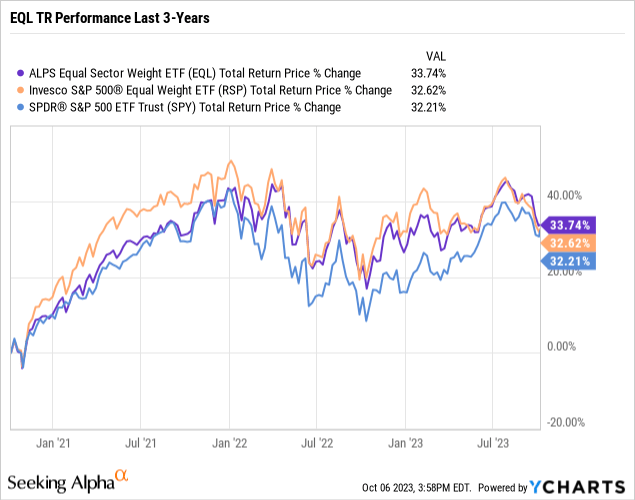
What’s the EQL ETF?
EQL is meant to trace the “NYSE Equal Sector Weight Index”. Because the identify implies, the key market sectors are equally weighted which incorporates Shopper Discretionary, Industrials, Supplies, Communication Companies, Well being Care, Financials, Know-how, Power, Actual Property, Shopper Staples, and Utilities.
supply: ALPS
Notably, the fund and underlying index make the most of the corresponding 11 Choose Sector SPDR ETFs that are a household of funds that focus particularly on focused publicity in these sectors. These are rebalanced each quarter to keep up an roughly ~9% weighting per ETF.
supply: ALPS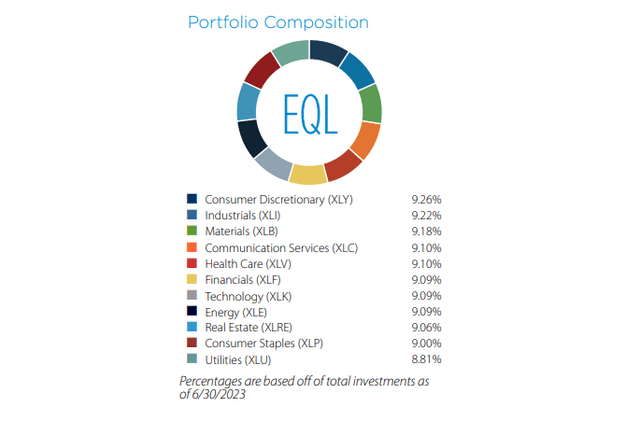
The chart beneath reveals the EQL ETF has returned 14% over the previous yr. The fund’s efficiency is the typical between every of the SPDR holdings contemplating a 41% return within the Know-how Choose Sector SPDR ETF (XLK) as an outperformer towards the -7% decline in lagging Utilities Choose Sector SPDR ETF (XLU) over the interval.
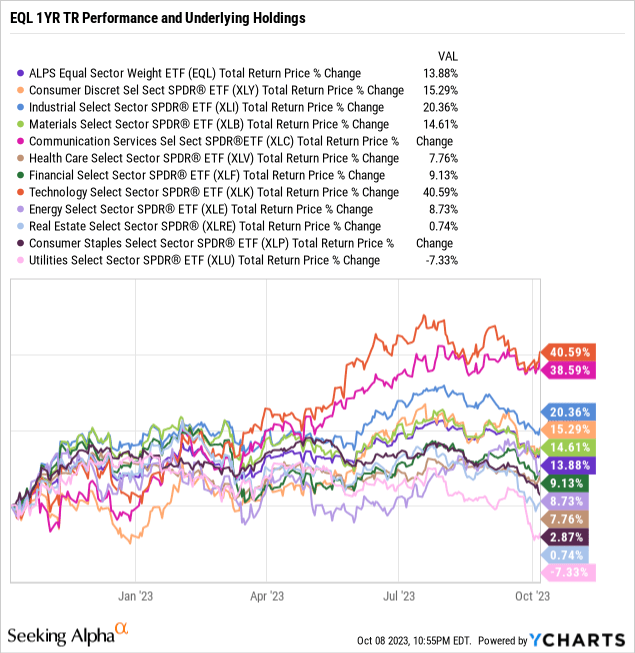
EQL vs SPY and RSP
On the similar time, it is essential to level out that EQL has underperformed the SPDR S&P 500 ETF Belief (SPY) which has returned a stronger 16% over the previous yr. That unfold is defined by the variations in sector allocations being that EQL is underweighting among the top-performing teams whereas overweighting among the laggards reflecting its equal-weight technique.
Particularly, EQL with its present 10% allocation to tech is nicely beneath the S&P 500 benchmark the place know-how shares comprise practically 30% of the fund. However, EQL’s place in Utilities, Actual Property, and the Primary Supplies sectors, with an 8-9% weighting, is nicely above their 2% place in SPY.
In search of Alpha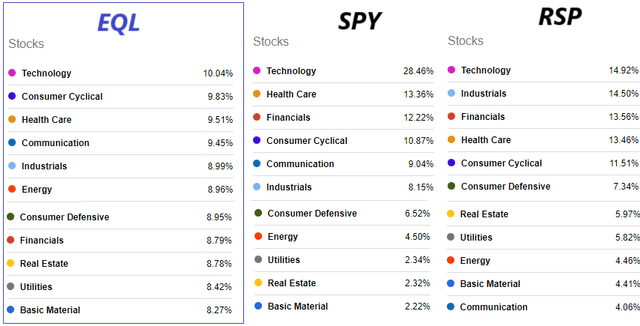
Right here, we will carry into the dialogue the Invesco S&P 500 Equal Weight ETF (RSP) for comparability functions. In distinction to EQL, RSP invests throughout all 500 shares within the S&P 500 Index at an equal proportion.
The explanation this strategy is totally different is predicated on the big selection within the variety of corporations represented in every sector. For instance, whereas there are 67 shares within the Know-how sector, solely 32 corporations are labeled as in Communication. RSP’s sector tilts replicate the sectors with probably the most shares.
What we discover is that EQL sits between RSP and SPY by way of having much less publicity to sure sectors like Know-how, Healthcare, and Financials however bigger positions within the smaller teams.
The takeaway right here is that EQL finally ends up being extra totally different from the S&P 500 than what RSP achieves. We’re not suggesting one fund is healthier than one other, however merely that their efficiency will fluctuate relying on present market circumstances.
Once more, the concept isn’t essentially to outperform the S&P 500 in all timeframes, however to as a substitute provide a type of diversification. Buyers with an present giant place in an S&P 500 fund might allocate towards EQL to basically enhance their efficient positions within the smaller sectors.
What’s Subsequent For EQL?
What we like about EQL is that the equal sector weight technique can proverbially put on a number of strategic hats in varied market environments. No matter which sector is outperforming, the fund will all the time take part in a market rally whereas lowering the affect of a crash on a selected sector on the draw back.
At the moment, we’re taking a look at EQL as a kind of contrarian play given it’s chubby among the worst-performing sectors relative to the S&P 500.
A significant market theme in latest months has been the surge of rates of interest amid considerations inflation stays too excessive and the Fed could also be pressured to proceed with financial tightening. On this case, EQL might be well-positioned to outperform if among the curiosity rate-sensitive sectors like utilities and actual property could make a comeback in comparison with their latest weak point.
This situation might play out if rates of interest pull again and defensive sectors obtain a bid amid the potential of a extra regarding deterioration to the worldwide economic system. The most recent growth of geopolitical dangers within the Center East has added to market dangers which might additional power a broader rebalancing throughout sectors in direction of defensive names in comparison with tech which was a winner for a lot of the yr.
Naturally, if lets say with certainty {that a} specific sector or perhaps a single inventory would lead greater from right here, the side of a diversified ETF can be pointless. That measure of uncertainty is what makes EQL attention-grabbing as a result of it removes a few of that guesswork.
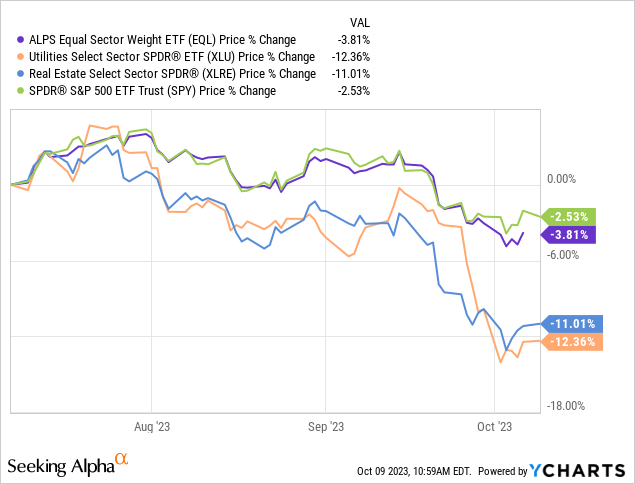
Ultimate Ideas
EQL is a high-quality fund that serves its objective with a compelling diversification technique and an affordable 0.26% expense ratio. Total, we anticipate the fund to ship a optimistic return over the subsequent yr, capturing an enhancing macro backdrop.
Buyers which might be already chubby mega-cap know-how shares or with a major place to conventional index funds could discover some profit in allocating via an equal sector weighting as a type of balancing threat.
By way of threat, the warning right here is that EQL wouldn’t be proof against a deeper broad market selloff. The actual sector tilts might additionally add to the volatility relying on the buying and selling motion.













